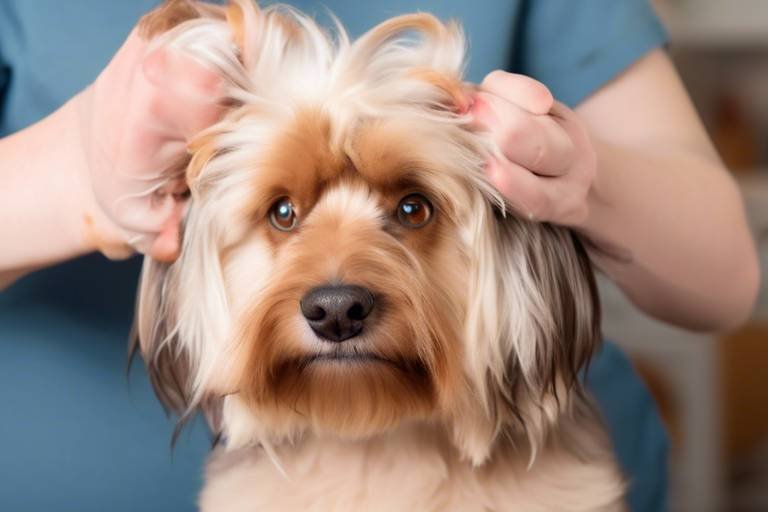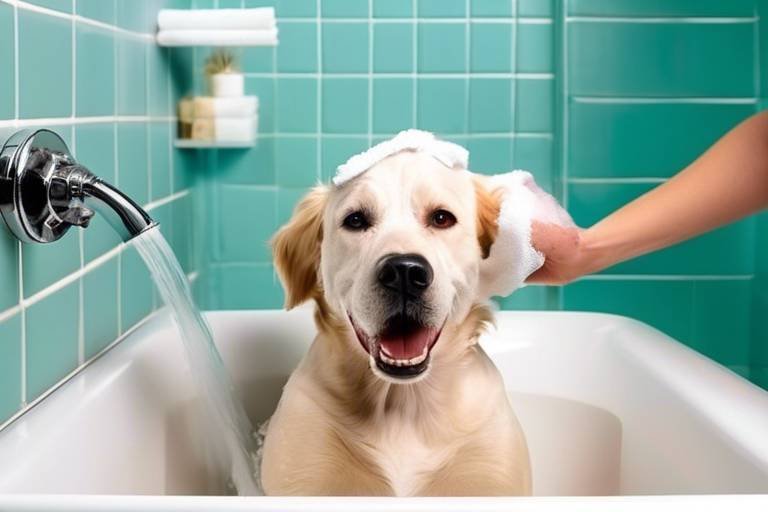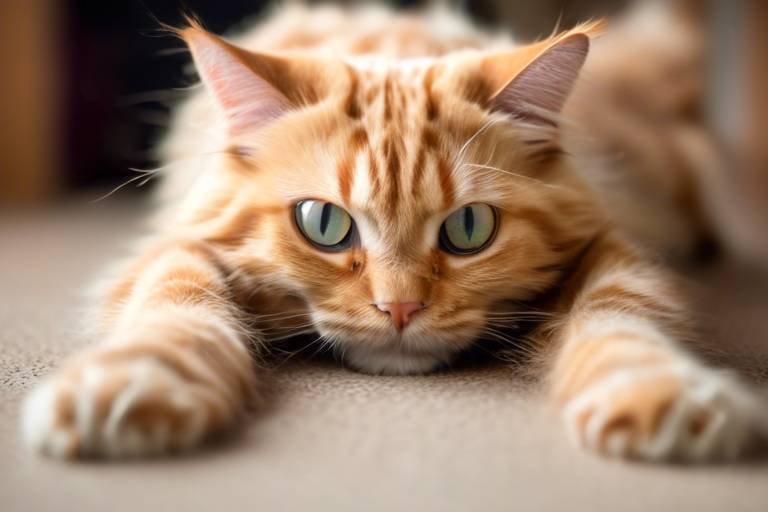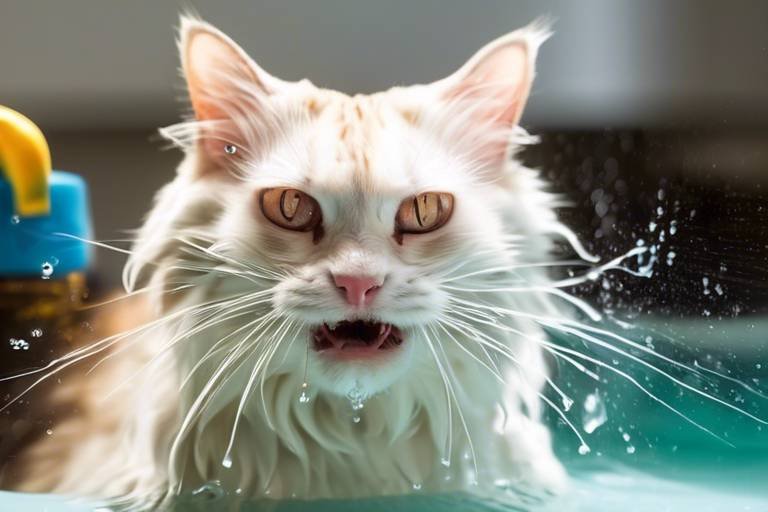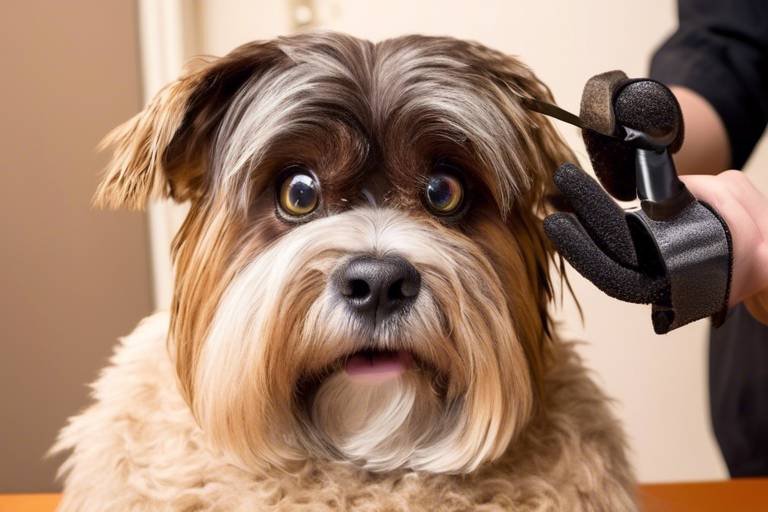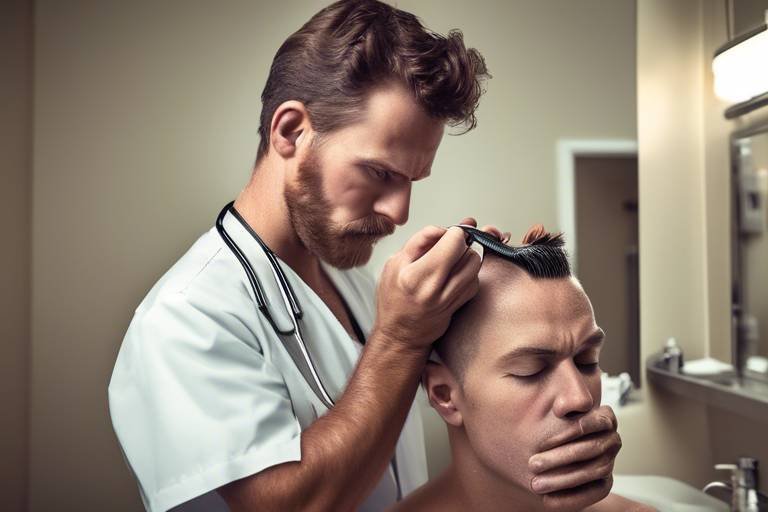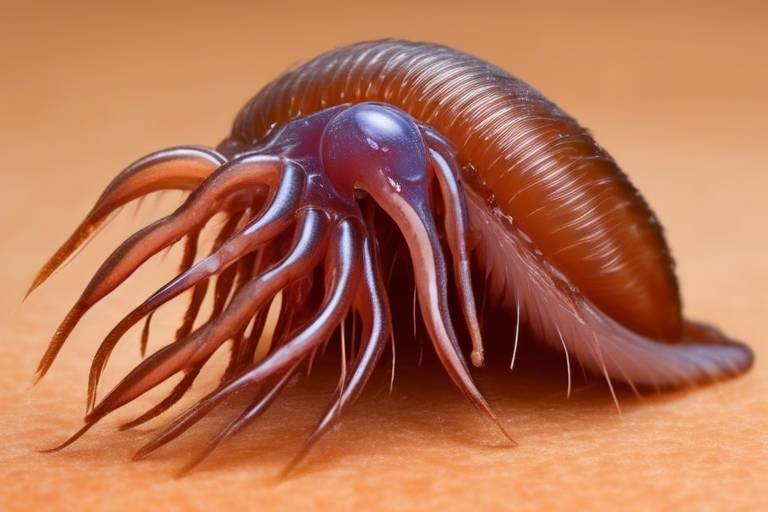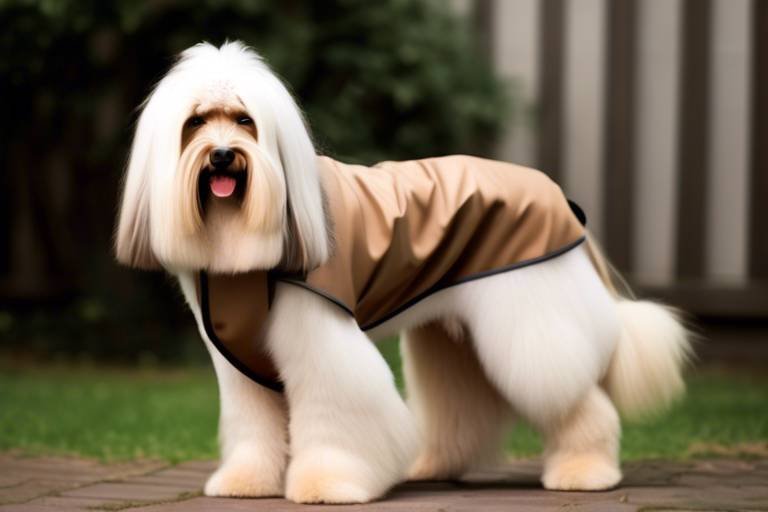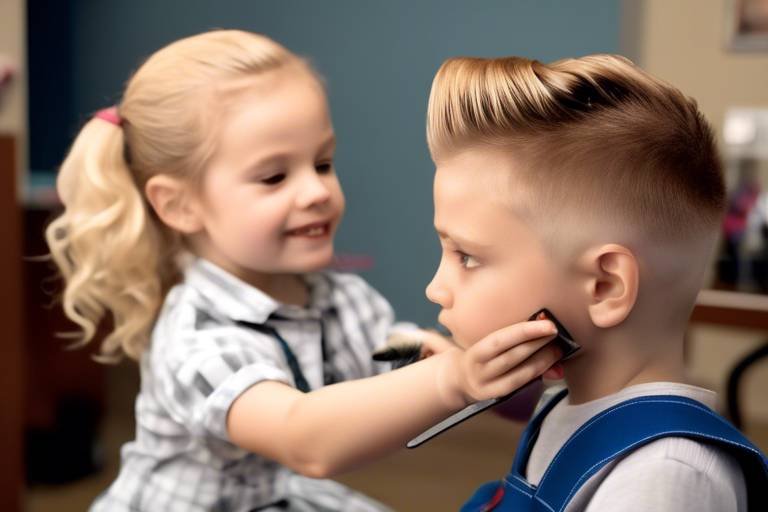How to Help Your Pet Transition to Regular Grooming
Grooming your pet isn’t just about keeping them looking fabulous; it’s also a crucial part of their overall health and well-being. Just like us, our furry companions benefit from regular grooming sessions. But let’s be honest—transitioning your pet into a consistent grooming routine can sometimes feel like trying to teach a cat to fetch! The key lies in understanding their unique needs and creating a positive atmosphere that makes grooming a delightful experience rather than a dreaded chore. In this article, we’ll explore practical tips and insights to help you ease your pet into regular grooming, ensuring a positive experience for both you and your furry friend.
Every pet has unique grooming requirements based on their breed and coat type. For instance, a fluffy Poodle needs different care than a sleek Beagle. Understanding these needs is the first step in creating a comfortable grooming experience for your pet. Take a moment to research your pet's breed and coat type. This knowledge will empower you to provide the best grooming routine tailored specifically for them. Remember, grooming isn’t just about aesthetics; it’s about maintaining their skin health and preventing issues like matting or skin infections.
Selecting appropriate grooming tools is essential for effective grooming. The right brushes and clippers can make a significant difference in your pet's comfort and the overall grooming process. Imagine trying to brush your hair with a fork—ouch, right? The same goes for your pet! Using the wrong tools can lead to discomfort and anxiety. So, let’s break down some essential tools that will make grooming a breeze.
Different coat types require specific brushes to avoid discomfort and ensure effective grooming. Knowing which brush to use can enhance the grooming experience for your pet. Here’s a quick overview of the best brushes for various coat types:
| Coat Type | Recommended Brush |
|---|---|
| Long-haired Breeds | Wide-toothed comb, slicker brush |
| Short-haired Breeds | Rubber grooming mitt, bristle brush |
| Curly-haired Breeds | Pin brush, detangling comb |
Long-haired pets often require specialized brushes to prevent matting and tangles. For example, a slicker brush is fantastic for removing loose hair and detangling knots. Regular grooming not only keeps their coat looking stunning but also helps you keep an eye on their skin condition. Think of it as a spa day for your pet!
Short-haired pets generally need less intensive grooming, but the right tools can still enhance their coat's shine and health. A simple rubber grooming mitt can work wonders by removing loose hair while giving your pet a soothing massage. It’s a win-win!
Establishing a consistent grooming schedule is vital for your pet’s well-being. Knowing how often to groom based on your pet’s needs can help you stay on track. For instance, long-haired breeds may need grooming every few days, while short-haired breeds might only require grooming once a week. Keeping a calendar can help remind you of grooming days, making it a routine that both you and your pet look forward to.
A calm and safe environment is crucial for your pet's grooming experience. If your pet is anxious, they may resist grooming, making the process difficult for both of you. To create a soothing space, consider the following:
- Find a quiet area away from distractions.
- Use soft lighting to create a relaxing atmosphere.
- Play gentle music to help calm nerves.
These small adjustments can make a world of difference in how your pet perceives grooming sessions.
Incorporating treats and praise during grooming can create a positive association for your pet. This approach encourages them to enjoy the grooming process over time. Think of it as a training session where every brush stroke is rewarded with love and treats. Soon, your pet will associate grooming with fun and affection!
Introducing grooming gradually helps your pet acclimate without stress. Start with short sessions to build their comfort and trust in the grooming routine. For example, begin by brushing them for just a few minutes and gradually increase the time as they become more comfortable. This technique is akin to easing into a cold pool—better to take it slow than to jump in all at once!
Understanding your pet's body language is essential for recognizing signs of stress during grooming. This knowledge allows you to adjust your approach for a more comfortable experience. Look out for behaviors like excessive panting, hiding, or trying to escape. These signs indicate that your pet may be feeling overwhelmed, and it’s crucial to take a step back and reassess your grooming strategy.
Identifying common signs of anxiety can help you respond appropriately and make grooming a more pleasant experience for your pet. Watch for:
- Excessive panting or drooling
- Trying to hide or escape
- Whining or growling when approached with grooming tools
If you notice these behaviors, it may be time to take a break and try again later.
If your pet shows severe distress during grooming, it may be time to consult a professional groomer. They can offer additional strategies and support for a smoother transition. Remember, it’s perfectly okay to seek help—after all, every pet deserves to feel comfortable and pampered!
Q: How often should I groom my pet?
A: It depends on your pet’s breed and coat type. Long-haired breeds typically need grooming every few days, while short-haired breeds may only require grooming once a week.
Q: What if my pet hates being groomed?
A: Start with short sessions and use positive reinforcement like treats and praise to create a positive association with grooming. Gradual introduction can also help.
Q: When should I consider professional grooming?
A: If your pet shows signs of severe anxiety or distress during grooming, it may be beneficial to consult a professional groomer for assistance.

Understanding Your Pet's Grooming Needs
Every pet is unique, and just like humans, they have their own specific grooming requirements. These needs can vary significantly based on factors such as breed, coat type, and even individual personality. For instance, a fluffy Golden Retriever has vastly different grooming needs compared to a sleek Beagle. Understanding your pet's grooming needs is the first step in creating a comfortable and enjoyable grooming experience for both you and your furry friend.
When it comes to grooming, it's essential to consider the following aspects:
- Coat Type: Long-haired pets often require more maintenance than short-haired ones. They can easily develop mats and tangles, which can be painful if not addressed promptly.
- Skin Health: Some pets may have sensitive skin that requires special shampoos or grooming techniques to avoid irritation.
- Shedding Patterns: Understanding when your pet sheds the most can help you plan grooming sessions more effectively, reducing the amount of fur around your home.
Moreover, certain breeds have unique characteristics that influence their grooming needs. For example, poodles have curly coats that require regular trimming and brushing to prevent matting, while short-haired breeds like Boxers may only need occasional brushing to remove loose hair and dirt. Understanding these differences is crucial in tailoring a grooming routine that keeps your pet looking and feeling their best.
Additionally, it's helpful to observe your pet's behavior during grooming sessions. Some pets may enjoy the process, while others might find it stressful. By paying close attention to their reactions, you can adjust your approach to make grooming a more positive experience. For instance, if your pet seems anxious, you might want to shorten the grooming sessions or introduce them to the tools gradually.
In summary, understanding your pet's grooming needs is not just about keeping them clean; it's about enhancing their overall well-being. By learning about their specific requirements, you can create a grooming routine that not only maintains their appearance but also fosters a sense of comfort and trust between you and your furry companion.

Choosing the Right Grooming Tools
When it comes to grooming your pet, choosing the right tools is just as important as the actual grooming process. Think of it like cooking; you wouldn't use a butter knife to chop vegetables, right? Similarly, using the appropriate grooming tools can make a world of difference in your pet's comfort and the effectiveness of the grooming session. It’s not just about aesthetics; it’s about ensuring your furry friend feels good while looking good!
First off, consider your pet's coat type. Different breeds come with different grooming needs, and this is where the right tools come into play. For instance, long-haired breeds require tools that can tackle tangles and mats, while short-haired breeds may benefit from tools that enhance their natural shine. Here’s a quick breakdown:
| Coat Type | Recommended Tools |
|---|---|
| Long-haired | Wide-toothed comb, slicker brush, dematting tool |
| Short-haired | Rubber grooming mitt, bristle brush, shedding blade |
In addition to the coat type, consider the size of your pet. Smaller pets may require smaller brushes and clippers, while larger breeds may need heavy-duty tools. It’s like picking the right size of shoes; you wouldn’t want to squeeze your feet into a size too small or trip over a size too big! Ensuring the tools fit your pet's size can make the grooming process smoother and less stressful.
Also, don't forget about the quality of the tools. Investing in high-quality grooming tools can save you headaches down the line. Cheap tools might break or cause discomfort, leading to a negative grooming experience for your pet. Look for tools that are well-reviewed and made from durable materials. You want to make sure that the tools you choose are not only effective but also safe for your furry friend.
Finally, remember that grooming is a two-way street. Your pet's comfort is paramount, so take your time to introduce the tools gradually. Let them sniff and explore the tools before you start using them. This simple act can help reduce their anxiety and foster a positive grooming environment. After all, a happy pet makes for a happy grooming session!
Essential Brushes for Different Coats
When it comes to grooming your furry friend, using the right brush is crucial for maintaining their coat's health and comfort. Different coat types have unique needs, and selecting the appropriate brush can make all the difference. For instance, long-haired breeds often suffer from tangles and matting if not brushed regularly. On the other hand, short-haired pets may require less frequent grooming but still benefit from the right tools to keep their coat shiny and healthy.
Let’s dive deeper into the essential brushes tailored for various coat types:
| Coat Type | Recommended Brush | Benefits |
|---|---|---|
| Long-haired | Pin Brush | Helps detangle hair and remove loose fur without pulling. |
| Medium-haired | Slicker Brush | Effectively removes mats and tangles while distributing natural oils. |
| Short-haired | Rubber Brush | Gently massages the skin while removing loose hair and dirt. |
| Wire-haired | Stripping Knife | Removes dead hair and maintains the coat's texture. |
Understanding the specific needs of your pet's coat is essential. For long-haired breeds, such as Persian cats or Golden Retrievers, a pin brush is often the best choice. This type of brush gently detangles their luscious locks while preventing breakage. If your pet's coat is prone to matting, consider incorporating a slicker brush into your grooming routine. This brush features fine, short wires close together, which effectively removes mats and distributes natural oils for a healthy shine.
Short-haired breeds, like Beagles or Boxers, typically require less intensive grooming. However, this doesn't mean they can skip the brush altogether! A rubber brush can be a game-changer for these pets. It not only removes loose hair but also provides a gentle massage that your pet will love. For wire-haired breeds, such as Terriers, a stripping knife is essential for maintaining the unique texture of their coat while effectively removing dead hair.
In conclusion, choosing the right brush for your pet's coat type is an integral part of the grooming process. Not only does it enhance their comfort, but it also contributes to their overall health. Remember, a well-groomed pet is a happy pet!
- How often should I groom my pet? It depends on the coat type. Long-haired breeds may need grooming several times a week, while short-haired breeds can often be groomed once a week.
- What if my pet doesn't like being brushed? Start slowly and use positive reinforcement, such as treats and praise, to help them associate grooming with a pleasant experience.
- Can I use human brushes on my pet? It's best to use brushes specifically designed for pets, as human brushes may not cater to their unique coat needs.
Long-haired Breeds
Long-haired pets, such as Persian cats, Golden Retrievers, and Shih Tzus, often require specialized grooming techniques to keep their luxurious coats healthy and tangle-free. Grooming these breeds is not just about aesthetics; it’s crucial for their overall well-being. A well-groomed coat can prevent skin issues and discomfort caused by mats and tangles. So, how do you ensure that your long-haired friend enjoys their grooming sessions?
First and foremost, choosing the right grooming tools is essential. For long-haired breeds, a combination of different brushes can work wonders. Here’s a quick guide:
| Brush Type | Purpose |
|---|---|
| Pin Brush | Great for detangling and removing loose fur. |
| Slicker Brush | Helps remove mats and tangles effectively. |
| Comb | Useful for finishing touches and removing small knots. |
Using the right brush can make a significant difference in your pet’s comfort during grooming. For example, a slicker brush can be a lifesaver when it comes to tackling stubborn mats. However, it’s important to be gentle and patient. Start by brushing small sections of your pet’s coat and gradually work your way through. This not only helps to avoid pulling on their skin but also builds trust between you and your furry companion.
Another crucial aspect of grooming long-haired breeds is establishing a routine. Regular grooming sessions, ideally once or twice a week, can help prevent mats from forming and keep your pet’s coat looking its best. Consider setting a specific day and time each week for grooming; this consistency can help your pet get used to the process. Over time, they may even start to look forward to these sessions as an opportunity for bonding.
Finally, don’t forget the importance of positive reinforcement. A few treats or some gentle praise can go a long way in making grooming a pleasant experience. If your pet associates grooming with positive outcomes, they’ll be more likely to cooperate and even enjoy the process. Remember, grooming should be a time of connection and care, not a battle!
- How often should I groom my long-haired pet? Generally, long-haired pets should be groomed at least once a week, but some may require more frequent grooming depending on their coat type and lifestyle.
- What if my pet hates being groomed? Start slowly and use positive reinforcement to create a better association with grooming. Gradual introductions can help ease their anxiety.
- Can I use human brushes on my pet? It's best to use brushes specifically designed for pets, as human brushes may not be suitable for their coat type and can cause discomfort.
Short-haired Breeds
When it comes to grooming , many pet owners might think that less fur means less fuss. However, this isn't entirely true! While it's true that short-haired pets generally require less intensive grooming than their long-haired counterparts, they still benefit significantly from regular grooming sessions. Grooming not only helps maintain the health of their coat but also promotes bonding between you and your furry friend.
Short-haired breeds, such as Beagles, Boxers, and Chihuahuas, have unique grooming needs that, when met, can lead to a shiny and healthy coat. One of the key aspects of grooming short-haired breeds is to choose the right brush. A soft-bristled brush or a grooming glove can work wonders, effectively removing loose hair while stimulating the skin and distributing natural oils. This not only enhances their coat's shine but also keeps their skin healthy.
Moreover, grooming sessions can serve as a fantastic opportunity to check for any skin issues. Regular brushing allows you to spot any unusual bumps, irritations, or parasites early on. It’s like a mini health check-up right at home! And let's not forget the joy of spending quality time with your pet, which can be incredibly rewarding. Just imagine how much your pet will appreciate those gentle strokes while you bond over a good brushing session!
To ensure a smooth grooming experience, consider the following tips:
- Frequency: Aim to brush your short-haired pet at least once a week. This helps minimize shedding and keeps their coat looking fresh.
- Tools: Invest in a good quality grooming glove or a soft brush designed for short-haired pets. These tools are gentle and effective.
- Technique: Use short, gentle strokes in the direction of hair growth. This will help avoid discomfort and make the experience more enjoyable for your pet.
In summary, while short-haired breeds may not require the same level of grooming as long-haired ones, they still need regular care to maintain a healthy coat and skin. So, grab that brush, and let the grooming adventures begin!
Q: How often should I groom my short-haired pet?
A: It's recommended to brush your short-haired pet at least once a week to keep their coat healthy and reduce shedding.
Q: What tools are best for grooming short-haired breeds?
A: A soft-bristled brush or grooming glove works well for short-haired pets. These tools help remove loose hair and stimulate the skin without causing discomfort.
Q: Can grooming help with skin issues?
A: Yes! Regular grooming allows you to check for any skin problems, such as bumps or irritations, early on, making it easier to address any concerns.
Q: Is grooming stressful for short-haired pets?
A: While some pets may initially be uneasy, creating a calm environment and using positive reinforcement can make grooming a pleasant experience.
Grooming Frequency Recommendations
Establishing a consistent grooming schedule is vital for your pet’s well-being and happiness. Just like we humans have our routines—think of it as brushing your teeth or having a weekly haircut—your furry friend thrives on predictability. But how often should you groom your pet? Well, that largely depends on their breed, coat type, and individual needs. Let’s break it down a bit more to make it easier for you.
For long-haired breeds, such as the majestic Persian cat or the fluffy Golden Retriever, grooming should ideally take place at least two to three times a week. This frequency helps to prevent tangles and mats, which can be uncomfortable and even painful for your pet. If you notice your pet's coat becoming tangled, you might need to increase the frequency to daily grooming sessions. Remember, a well-groomed coat is not just about looks; it also promotes healthy skin and reduces shedding!
On the other hand, short-haired breeds, like Beagles or Boxers, typically require less frequent grooming, usually once a week. However, brushing them regularly can still enhance their coat's shine and remove loose hair. It’s like giving them a mini spa treatment! Plus, it’s a great way to bond with your pet. If your short-haired pet is shedding more than usual, consider increasing the frequency to twice a week during shedding seasons.
Now, let’s not forget about the special needs pets. Some pets may have skin conditions or sensitivities that require more tailored grooming schedules. For instance, if your pet has allergies, you might need to groom them more frequently to keep allergens at bay. Always consult with your veterinarian for personalized recommendations based on your pet’s unique needs.
Here’s a quick reference table to help you visualize grooming frequency based on coat type:
| Coat Type | Recommended Grooming Frequency |
|---|---|
| Long-haired Breeds | 2-3 times a week (daily if matted) |
| Short-haired Breeds | Once a week (twice during shedding season) |
| Special Needs Pets | Consult with a veterinarian for tailored advice |
In conclusion, finding the right grooming frequency for your pet is essential for maintaining their health and happiness. By understanding their specific needs and sticking to a routine, you can make grooming a positive experience that both you and your pet will look forward to. So grab those brushes and clippers, and let’s make grooming a fun and enjoyable time!
- How often should I groom my pet? It depends on the breed and coat type. Long-haired pets need more frequent grooming than short-haired ones.
- What tools do I need for grooming? The right brushes and clippers tailored to your pet’s coat type are essential for effective grooming.
- Can I groom my pet at home? Absolutely! With the right tools and techniques, grooming at home can be a great bonding experience.
- What if my pet doesn't like grooming? Gradually introduce grooming sessions and use positive reinforcement to help them feel more comfortable.

Creating a Positive Grooming Environment
Creating a positive grooming environment is crucial for ensuring that your pet feels safe, relaxed, and comfortable during their grooming sessions. Imagine walking into a room filled with soothing sounds, soft lighting, and familiar scents—this is the kind of atmosphere you want to create for your furry friend. A calm environment not only helps reduce anxiety but also makes the grooming process more enjoyable for both of you.
To start, consider the location where you will groom your pet. Choose a quiet space away from loud noises or distractions that could startle them. If possible, set up a designated grooming area equipped with everything you need. Having a consistent spot can help your pet associate that space with grooming, easing their nerves over time.
Another important aspect is the temperature of the room. Pets can be sensitive to heat and cold, so make sure the area is comfortable for them. You might even want to add a cozy blanket or a soft mat where they can sit or lie down during grooming. This tactile comfort can make a world of difference.
Additionally, consider using calming products such as pheromone diffusers or sprays designed to reduce anxiety in pets. These can help create a soothing atmosphere and encourage relaxation. You can also play soft music or nature sounds in the background, as these can further enhance the calming environment. Just like humans, pets can benefit from a little ambiance!
When it comes to grooming tools, keep them organized and within reach, so you won’t have to leave your pet unattended. This not only keeps the process smooth but also reassures your pet that they are safe with you. Remember, your demeanor plays a significant role; if you’re calm and relaxed, your pet is likely to feel the same way. Speak softly and offer gentle touches to build trust.
Lastly, don't forget to incorporate positive reinforcement throughout the grooming process. This could be in the form of treats, praise, or gentle petting. By rewarding your pet for being calm and cooperative, you’ll help them develop a positive association with grooming. Over time, they’ll look forward to these sessions instead of dreading them.
- How often should I groom my pet? The frequency depends on your pet's breed and coat type. Long-haired breeds may need grooming several times a week, while short-haired breeds might only require it once a month.
- What if my pet shows signs of anxiety during grooming? If your pet displays anxiety, try to identify what triggers it and adjust your approach. Gradually introduce grooming and consider consulting a professional groomer for additional support.
- Can I use regular human grooming tools on my pet? It's best to use tools specifically designed for pets, as human grooming tools may not be suitable for their coat types and can cause discomfort.
Using Positive Reinforcement
When it comes to grooming your furry friend, positive reinforcement can be a game changer! Just like how we respond better to encouragement than criticism, pets thrive on praise and rewards. Imagine your pet's tail wagging in excitement every time they see the grooming tools; that's the kind of joyful association we want to create!
Start by introducing grooming tools gradually. Let your pet sniff and explore the brush or comb before you even use it. This helps them become familiar with the tools and reduces any initial anxiety. During the grooming session, be generous with treats and praise. For instance, after a few strokes with the brush, reward your pet with a small treat and some affectionate words. This simple act can transform their perception of grooming from a chore to a delightful experience.
It's essential to keep the sessions short and enjoyable. If your pet seems to be getting restless or anxious, take a break. This is where positive reinforcement can be particularly effective. You might say something like, "Good boy! You did so well!" while giving them a treat. This not only calms them but also builds trust and encourages them to look forward to the next grooming session.
Consider creating a grooming routine that includes their favorite activities. For example, you could groom them while they enjoy a tasty chew or their favorite toy. This multitasking approach can make grooming feel less like a chore and more like a fun bonding time. Over time, your pet will associate grooming with positive experiences, making it easier for both of you!
Incorporating positive reinforcement into grooming is not just about treats; it's about fostering a loving environment. Use a gentle voice, maintain eye contact, and show affection throughout the process. Your pet will pick up on your positive energy, and that will help them relax. Remember, the goal is to create a stress-free grooming experience that both you and your pet can enjoy!
- How often should I groom my pet? The frequency of grooming depends on your pet's breed and coat type. Long-haired breeds may need grooming several times a week, while short-haired breeds might only require it once a week.
- What if my pet hates grooming? Start slowly and use positive reinforcement. Gradually increase the duration of grooming sessions and always reward your pet for their cooperation.
- Can I use human grooming tools on my pet? It's best to use tools specifically designed for pets, as they are tailored to their unique coat types and sensitivities.
- What should I do if my pet shows signs of stress during grooming? If your pet becomes anxious or stressed, take a break. Observe their body language and consider consulting a professional groomer for additional support.
Gradual Introduction to Grooming
Transitioning your pet to a regular grooming routine doesn’t have to be a daunting task. In fact, taking a gradual approach can make all the difference. Just like you wouldn’t jump into a cold pool without easing in, your furry friend deserves the same gentle introduction to grooming. Start by setting aside short, manageable grooming sessions to help your pet acclimate to the process. This can be as simple as brushing them for just a few minutes each day.
Begin with familiarization. Let your pet sniff and explore the grooming tools before you use them. This can help reduce their anxiety. Once they seem comfortable with the tools, you can start introducing the grooming process itself. For instance, you might begin by gently brushing a small area of their coat, gradually increasing the time and area you cover as they become more accustomed to the sensation. The key is to move at a pace that feels right for your pet.
During these initial sessions, pay close attention to your pet’s reactions. If they seem anxious or uncomfortable, it’s okay to take a step back. You might even want to incorporate playtime or treats as a reward after each session. This positive reinforcement can create a more enjoyable experience and encourage them to look forward to grooming time. Remember, patience is crucial here; every pet is different, and some may take longer to adapt than others.
To further enhance this gradual introduction, consider the following tips:
- Start with just a few minutes of grooming each session.
- Use calming music or soft voices to create a soothing atmosphere.
- Incorporate breaks if your pet shows signs of stress.
- Always end on a positive note, regardless of how much grooming was accomplished.
As your pet becomes more comfortable with the grooming process, you can slowly increase the duration and frequency of the sessions. This gradual approach not only helps in building trust but also fosters a positive relationship between you and your furry friend. Before you know it, your pet may even start to look forward to their grooming sessions, making it a bonding experience rather than a chore.
Q: How often should I groom my pet?
A: Grooming frequency depends on your pet’s breed and coat type. Long-haired breeds may require grooming every few days, while short-haired breeds can often be groomed weekly.
Q: What should I do if my pet resists grooming?
A: If your pet resists grooming, try to introduce the process gradually and use positive reinforcement. If the resistance continues, consider consulting a professional groomer for help.
Q: Can grooming help with my pet's anxiety?
A: Yes! Regular grooming can help desensitize your pet to the process, reducing anxiety over time. Creating a positive and calm environment during grooming sessions is essential.

Recognizing Signs of Stress in Pets
Understanding your pet's body language is crucial when it comes to grooming. Just like humans, pets can experience stress and anxiety, especially when faced with unfamiliar situations like grooming. Recognizing the signs of stress can help you adjust your approach, making the experience more comfortable for your furry friend. It's important to remember that each pet is unique, and their reactions may vary. However, there are common signs to look out for that can indicate your pet is feeling uneasy.
Some typical signs of stress in pets include:
- Excessive panting: If your pet is panting heavily, even in a cool environment, it could be a sign of anxiety.
- Hiding: Pets that seek out secluded spots may be trying to escape the stress of grooming.
- Whining or barking: Vocalizations can indicate discomfort or fear, so pay attention to your pet's sounds.
- Tail position: A tucked tail often indicates fear, while a stiff tail can suggest agitation.
- Body posture: If your pet is crouching or trying to back away, they are likely feeling stressed.
It's essential to create a positive grooming experience, so if you notice these signs, consider taking a step back. Perhaps it's time to shorten the grooming session or take a break. You might also try to soothe your pet with gentle words or treats to help them relax.
In some cases, it may be beneficial to consult a professional groomer. They can provide additional strategies and support for easing your pet into the grooming routine. Remember, patience is key. Just like building trust in a relationship, it takes time for your pet to feel comfortable with grooming. By being observant and responsive to their needs, you can help create a more enjoyable experience for both you and your furry companion.
Q: How can I tell if my pet is stressed during grooming?
A: Look for signs such as excessive panting, hiding, whining, or changes in body posture. If your pet seems uncomfortable, it's important to adjust your approach.
Q: What should I do if my pet shows signs of anxiety?
A: If your pet is showing signs of anxiety, consider shortening the grooming session, taking breaks, or using treats and praise to create a positive association with grooming.
Q: When should I consult a professional groomer?
A: If your pet exhibits severe distress during grooming, it may be time to consult a professional. They can offer expert advice and techniques to help ease your pet's anxiety.
Common Signs of Anxiety
When it comes to our furry companions, understanding their emotions is crucial for their well-being. Just like humans, pets can experience anxiety, especially during grooming sessions. Recognizing the common signs of anxiety in your pet can make a world of difference in how you approach grooming. Imagine trying to relax in a noisy, chaotic environment; it’s tough, right? Similarly, your pet may exhibit certain behaviors that signal they are feeling stressed or anxious.
One of the most noticeable signs is excessive panting. If your dog or cat is panting heavily, even in a cool environment, it could be a sign of anxiety. Another behavior to watch for is hiding. If your pet suddenly retreats to a corner or under the bed when you bring out the grooming tools, they might be trying to escape the situation. Additionally, whining or vocalizing more than usual can indicate discomfort. This vocalization is their way of expressing that they are not okay with what's happening.
Some pets may also display physical signs such as trembling or shaking. If you notice your pet trembling, it’s essential to pause and assess the situation. Furthermore, licking their lips or yawning excessively can be subtle signs of anxiety, even if they’re not directly related to grooming. These actions are often a pet's way of self-soothing.
To help you better understand these signs, here’s a quick reference table:
| Sign of Anxiety | Description |
|---|---|
| Excessive Panting | Heavy breathing even in a relaxed setting. |
| Hiding | Seeking refuge in a safe space away from grooming tools. |
| Vocalizing | Whining or making noises to express discomfort. |
| Trembling | Shaking or quivering when approached with grooming tools. |
| Licking Lips/Yawning | Self-soothing behaviors indicating stress. |
It's important to remember that every pet is unique, and their reactions to grooming can vary. If you notice any of these signs, take a moment to breathe and reassess the situation. You might need to take a step back, give your pet some space, or even consider consulting a professional groomer for guidance. After all, the goal is to make grooming a positive experience for both you and your beloved pet.
Here are some common questions pet owners have regarding grooming and anxiety:
- What should I do if my pet shows signs of anxiety during grooming? It's best to stop the grooming session and give your pet some time to relax. You can try again later or consult a professional groomer.
- How can I help my pet feel more comfortable during grooming? Use positive reinforcement, such as treats and praise, to create a positive association with grooming.
- Are there specific breeds more prone to grooming anxiety? Yes, some breeds may be more sensitive to grooming due to their temperament or past experiences.
When to Consult a Professional
Grooming your pet at home can be a rewarding experience, but there are times when it’s best to seek the expertise of a professional groomer. If you notice that your furry friend is becoming increasingly anxious or distressed during grooming sessions, it might be a sign that they need a helping hand. Professional groomers are trained to handle various breeds and temperaments, and they possess the skills to make the grooming experience more comfortable for your pet.
Another scenario where consulting a professional is advisable is if your pet has a particularly challenging coat type. For instance, breeds with thick, curly, or double coats often require specialized techniques to prevent matting and ensure a healthy look. If you’re unsure about how to manage your pet’s coat, don’t hesitate to reach out to a groomer who can provide the necessary care. They can also offer valuable advice on maintaining your pet's coat between grooming sessions.
It's also essential to consider your pet's health. If your pet has any medical conditions, such as skin allergies or sensitivities, a professional groomer can provide a tailored grooming experience that takes these factors into account. They often have access to specialized products that are gentle on your pet's skin and coat. If you’re ever in doubt about the right approach to grooming, consulting a professional can save you a lot of stress and potential issues.
In some cases, if your pet requires advanced grooming techniques, such as nail trimming, ear cleaning, or anal gland expression, it’s best to leave these tasks to the professionals. These procedures require a certain level of expertise and can be uncomfortable for your pet if not done correctly. By trusting a professional, you can ensure that these sensitive areas are handled with care.
Ultimately, the goal is to create a positive grooming experience for your pet. If you find that your attempts at grooming are met with resistance or fear, it’s a clear indication that your pet may benefit from professional assistance. Remember, grooming should be a bonding experience, not a battle!
- How often should I take my pet to a professional groomer?
The frequency depends on your pet's breed and coat type. Generally, long-haired breeds may need grooming every 4-6 weeks, while short-haired breeds may require less frequent visits.
- Can I groom my pet at home and still consult a professional?
Absolutely! Many pet owners choose to groom their pets at home for basic maintenance but consult professionals for more intensive grooming needs.
- What should I look for in a professional groomer?
Look for groomers with good reviews, certifications, and experience with your pet's breed. A friendly demeanor and a clean, safe environment are also crucial.
Frequently Asked Questions
- How often should I groom my pet?
The grooming frequency depends on your pet's breed and coat type. For example, long-haired breeds may need grooming every few days to prevent matting, while short-haired breeds might only require grooming once a week. It's best to establish a routine that suits your pet's specific needs.
- What grooming tools do I need for my pet?
The essential grooming tools vary based on your pet's coat type. Long-haired pets typically need a slicker brush and a comb, while short-haired pets can benefit from a rubber brush or a bristle brush. Investing in quality tools can make a significant difference in your pet's grooming experience.
- How can I create a positive grooming environment?
To create a calm grooming environment, choose a quiet, comfortable space free from distractions. Use soothing music, and have treats on hand to reward your pet during grooming sessions. This helps build a positive association and reduces anxiety for your furry friend.
- What are the signs that my pet is stressed during grooming?
Common signs of stress in pets include excessive panting, hiding, or trying to escape. If you notice these behaviors, it's important to take a break and reassess your grooming technique. Always prioritize your pet's comfort and well-being during grooming sessions.
- When should I seek professional help for grooming?
If your pet shows severe distress or anxiety during grooming, it may be time to consult a professional groomer. They can provide expert advice and techniques to help your pet feel more comfortable and ensure a smoother grooming experience.

